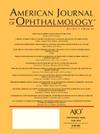先天性限制性斜视伴眼眶结构异常:MRI表现及临床特征。
IF 4.1
1区 医学
Q1 OPHTHALMOLOGY
引用次数: 0
摘要
目的对眼眶结构异常(AOS)的磁共振成像(MRI)特征进行评估和分类,并将这些结果与临床表现相关联。方法回顾性分析2010年7月至2024年10月期间35例确诊为先天性局限性斜视和AOS患者的详细临床资料。主要结果测量检查了 AOS、眼外肌(EOMs)和眼运动神经的形态特征。结果这项回顾性研究共纳入 35 例患者(21 名男性和 14 名女性)。平均年龄(±SEM)为 6.9±0.8 岁(范围:2-22 岁)。16例患者右眼受累,19例患者左眼受累。AOS 可分为三种类型:类型 1,从直肌延伸到后巩膜的离散异常带(25.7%),其中下直肌受影响最大;类型 2 是指观察到的眼外肌(EOMs)之间的异常连接(65.第 3 种是后巩膜与周围视神经鞘之间的异常连接,并延伸至眼球赤道部(8.6%)。所有患者都存在不同程度的眼球运动受限和斜视。结论离散的异常带最常累及IR,而异常的EOM连接主要发生在SR和MR之间。眼睑位置不正提示可能存在AOS。本文章由计算机程序翻译,如有差异,请以英文原文为准。
Congenital Restrictive Strabismus Associated With Anomalous Orbital Structures: MRI Findings and Clinical Characteristics
PURPOSE
To evaluate and classify the magnetic resonance imaging (MRI) features of anomalous orbital structures (AOS) and correlate these findings with clinical manifestations.
DESIGN
Retrospective, observational case series.
METHODS
The detailed clinical data from 35 patients diagnosed with congenital restrictive strabismus and AOS were retrospectively reviewed between July 2010 and October 2024. All patients underwent brain stem and intraorbital MRI.
MAIN OUTCOME MEASURES
The morphological features of AOS, extraocular muscles (EOMs), and ocular motor nerves were examined.
RESULTS
This retrospective study included 35 cases (21 males and 14 females). The mean ± SEM age was 6.9 ± 0.8 years (range: 2-22 years). Sixteen patients had right-eye involvement, and 19 had left-eye involvement. AOS were categorized into three types: Type 1, discrete anomalous bands extending from the rectus muscles to the posterior sclera (25.7%), with the inferior rectus (IR) being the most affected; Type 2 refers to anomalous connections observed between the extraocular muscles (EOMs) (65.7%), often occurring in the area between the superior rectus (SR) and medial rectus (MR); Type 3, abnormal connection between the posterior sclera and the surrounding optic nerve sheath and extending to the equatorial region of the globe (8.6%). Varying degrees of restricted eye movements and strabismus were observed in all patients. Most patients also exhibited amblyopia and eyelid malposition in the affected eye.
CONCLUSIONS
Discrete anomalous bands most commonly involve the IR, while abnormal EOM connections primarily occur between the SR and MR. Eyelid malposition could suggests the possible presence of AOS.
求助全文
通过发布文献求助,成功后即可免费获取论文全文。
去求助
来源期刊
CiteScore
9.20
自引率
7.10%
发文量
406
审稿时长
36 days
期刊介绍:
The American Journal of Ophthalmology is a peer-reviewed, scientific publication that welcomes the submission of original, previously unpublished manuscripts directed to ophthalmologists and visual science specialists describing clinical investigations, clinical observations, and clinically relevant laboratory investigations. Published monthly since 1884, the full text of the American Journal of Ophthalmology and supplementary material are also presented online at www.AJO.com and on ScienceDirect.
The American Journal of Ophthalmology publishes Full-Length Articles, Perspectives, Editorials, Correspondences, Books Reports and Announcements. Brief Reports and Case Reports are no longer published. We recommend submitting Brief Reports and Case Reports to our companion publication, the American Journal of Ophthalmology Case Reports.
Manuscripts are accepted with the understanding that they have not been and will not be published elsewhere substantially in any format, and that there are no ethical problems with the content or data collection. Authors may be requested to produce the data upon which the manuscript is based and to answer expeditiously any questions about the manuscript or its authors.

 求助内容:
求助内容: 应助结果提醒方式:
应助结果提醒方式:


